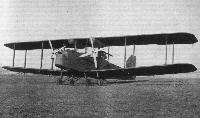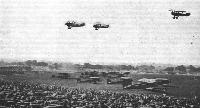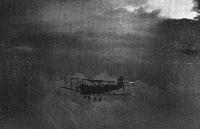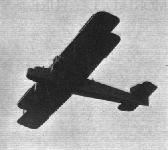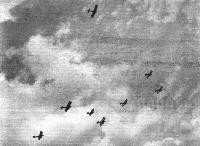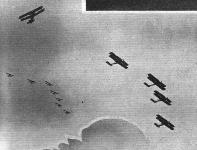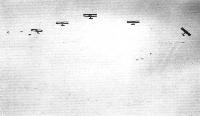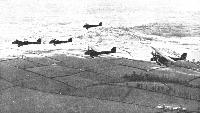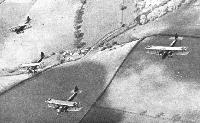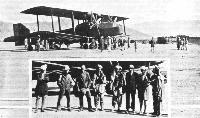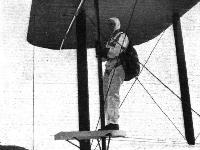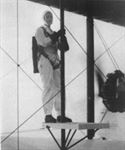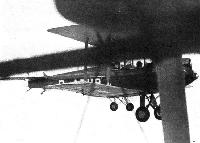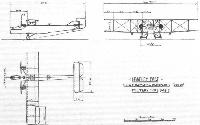
Описание
Страна : Великобритания
Год : 1923
Тяжелый ночной бомбардировщик с экипажем из четырех человек
Варианты
- Handley Page - H.P.18 (W.8) / H.P.30 (W.10) - 1919 - Великобритания
- Handley Page - Hyderabad/H.P.24 / Hinaidi/H.P.33 / Clive/H.P.35 - 1923 - Великобритания
- Handley Page - Hamilton W.8e/H.P.26 / Hampstead W.9/H.P.27 - 1924 - Великобритания
Handley Page H.P.24 Hyderabad, H.P.33/H.P.36 Hinaidi и H.P.35 Clive
В соответствии со спецификацией 31/22 компания "Handley Page" на базе своего гражданского самолета W.8 спроектировала для британских ВВС тяжелый двухмоторный ночной бомбардировщик, поступивший на вооружение под обозначением Hyderabad. Прототип, обозначенный вначале как W.8d (позднее H.P.24), совершил первый полет в октябре 1923 года. Силовая установка новой машины включала два W-образных двигателя Napier Lion IIB мощностью по 450 л. с. Опытная эксплуатация машины была оценена положительно, самолет превосходил аналогичный Vickers Virginia Mk III, и для британских ВВС были построены 45 экземпляров. Самолеты поступили в 99-ю эскадрилью в декабре 1925 года и оставались в строевых частях до 1930 года, после чего до конца 1933 года эксплуатировались во Вспомогательных ВВС.
Усовершенствованный вариант был разработан согласно спецификации 13/29 Министерства авиации и получил обозначение Hinaidi Mk I (H.P.33). Он имел два звездообразных двигателя Bristol Jupiter VIII мощностью 440 л. с., за первой машиной последовали еще два опытных экземпляра, построенных компанией "Handley Page", причем второй из них имел фюзеляж модели W.10 - для использования в качестве транспортно-десантного самолета. Затем были выпущены еще шесть серийных Hinaidi Mk I, последние три из них имели цельнометаллический фюзеляж и послужили основой для создания одного прототипа H.P.36 и 33-х серийных машин Hinaidi Mk II, имевших аналогичный цельнометаллический фюзеляж. В дополнение к новым самолетам еще семь бомбардировщиков Hyderabad были переделаны по стандарту Hinaidi Mk I. Hinaidi, как и Hyderabad, поступили в 99-ю эскадрилью и продолжали использоваться в строевых частях до ноября 1933 года, пока их не сменили на Heyford. Второй опытный образец Hinaidi Mk I, имевший цельнодеревянную конструкцию и фюзеляж самолета W.10, был позднее переименован в Clive Mk I (H.P.35), он вмещал 23 десантника. Позже в эксплуатацию поступили два серийных транспортных самолета Clive Mk II, которые имели уже цельнометаллическую силовую конструкцию. Самолеты Clive Mk II базировались в Лахоре (Индия) и использовались в течение нескольких лет в составе подразделения тяжелых транспортных самолетов Королевских ВВС Великобритании. Впоследствии Clive Mk I был переоборудован по стандарту W.10 и стал обозначаться Clive Mk III, но его серийное производство не было начато. Сам прототип был продан сэру Алану Кобхэму, который использовал его в ходе своих демонстрационных полетов, а также для испытаний системы дозаправки в полете.
ТАКТИКО-ТЕХНИЧЕСКИЕ ХАРАКТЕРИСТИКИ
Handley Page Hinaidi Mk II
Тип: тяжелый ночной бомбардировщик с экипажем из четырех человек
Силовая установка: два звездообразных ПД Bristol Jupiter VIII мощностью по 440 л. с. (328 кВт)
Летные характеристики: максимальная скорость на уровне моря 196 км/ч; крейсерская скорость на оптимальной высоте 121 км/ч; начальная скороподъемность 116 м/мин; набор высоты 2000 м - за 11 мин 48 с; практический потолок 4420 м; дальность 1368 км
Масса: пустого 3647 кг; максимальная взлетная 6577 кг
Размеры: размах крыльев бипланной коробки 22,86 м; длина 18,03 м; высота 5,18 м; площадь крыльев 136,66 м2
Вооружение: один 7,7-мм наводимый пулемет Lewis в носовой части фюзеляжа, один наводимый 7,7-мм пулемет Lewis в надфюзеляжной стрелковой установке для обороны задней полусферы и один наводимый 7,7-мм пулемет Lewis в подфюзеляжной установке для обороны задней полусферы, плюс до 658 кг бомб на четырех подфюзеляжных и шести подкрыльевых узлах подвески - в стандартном варианте четыре 113-кг и четыре 51 -кг бомбы, либо восемь 51-кг бомб под фюзеляжем, либо две 249-кг или 236-кг бомбы, либо четыре 113-кг или 104-кг бомбы, или шесть 51-кг бомб под крылом
- Описание
Фотографии
-
Мировая Авиация 149
Регистрационный номер: J9126 [11], G-ABYX [11] J9126, прототип Clive Mk I, позже был переоборудован в гражданский авиалайнер по стандарту W.10 и использовался сэром Аланом Кобхэмом.
-
Aeroplane Monthly 1993-08 / P.Jarrett - By day and by night: Hyderabads and Hinaidis
Регистрационный номер: J6994 [3] This view of Hyderabad prototype J6994 was taken at RAF Martlesham Heath in 1924.
-
Мировая Авиация 95
23 октября 1923г.: совершил полет Handley Page Hyderabad, военный вариант авиалайнера W.8. Самолет в 1925-1930 годах эксплуатировался четырьмя эскадрильями британских ВВС.
Handley Page "Hyderabad" (Two Napier "Lions") The Handley Page "Hyderabad" may be said to be the development, for service purposes, of the famous Handley Page twin-engined commercial aeroplanes. The service type is designated officially as a "four-seater medium range bomber," and those familiar with Handley Page commercial aeroplanes will note that certain alterations have been made in the fuselage, the nose of which has been re-designed so as to admit of a gunner in front, with the pilot in a raised position immediately aft of the front gunner's cockpit. The only squadron equipped with "Hyderabads" is No. 99 (Bombing) Squadron, Bircham Newton. -
Aeroplane Monthly 1993-08 / P.Jarrett - By day and by night: Hyderabads and Hinaidis
Регистрационный номер: J6994 [3] An earlier view of the prototype Hyderabad, taken in 1923 at Cricklewood.
-
Aeroplane Monthly 1993-08 / P.Jarrett - By day and by night: Hyderabads and Hinaidis
Регистрационный номер: J6994 [3] J6994, the Hyderabad first prototype, was first flown in October 1923. This photograph was taken in May 1924.
-
Aeroplane Monthly 1993-08 / P.Jarrett - By day and by night: Hyderabads and Hinaidis
Регистрационный номер: J7745 [8] Hyderabad J7445, built in 1926, was converted into the prototype Hinaidi at the A&AEE and was first flown in its new form on March 26, 1927.
-
Flight 1924-07 / Flight
AT THE R.A.F. PAGEANT: One of the larger machines which took part in the "Fly Past": The Handley Page "Hyderabad" and the Vickers "Virginia," twin-engined (Napier "Lions") bombers.
Другие самолёты на фотографии: Vickers Virginia - Великобритания - 1922
-
Aeroplane Monthly 1985-03 / A.Lumsden, T.Heffernan - Probe probare (11)
The main difference between the Hinaidi and the Hyderabad was the engines. The Hyderabad, seen here, was powered with two 450 h.p. Napier Lions; note the rectangular radiators. The major production versions of the Hyderabad featured metal instead of wooden construction.
-
Flight 1926-01 / Flight
MANOEUVRABILITY: Two views of the Handley Page "Hyderabad" night bomber. This machine is fitted with two Napier "Lion" engines. In the flights during which these photographs were taken the machine was piloted by Capt. Wilcockson, who seemed to handle the "Hyderabad" as if it were a scout.
-
Flight 1926-01 / Flight
THE HANDLEY PAGE "HYDERABAD": These three views show the machine from different angles and give a good idea of the general lay-out, which is based upon that of the commercial W.8 type, although certain minor changes have been made for the use of the machine as a night bomber.
-
Flight 1928-06 / Flight
HANDLEY PAGE "HYDERABAD": Night Bomber, with two Napier "Lion" Engines.
-
Aeroplane Monthly 1993-09 / O.Thetford - By day and by night
Регистрационный номер: J7748 Hyderabad J7748, a former 99 Sqn aircraft, pictured in December 1926 at the time it was being used on autopilot tests. It was returned to the squadron in March 1927.
-
Aeroplane Monthly 1993-08 / P.Jarrett - By day and by night: Hyderabads and Hinaidis
Регистрационный номер: J9031 Hyderabad J9031 was first flown on March 16, 1928, and delivered to 99 Sqn. After coming down on Harrow School’s playing fields in February 1929 the aircraft was rebuilt as a Hinaidi Mk I.
-
Aeroplane Monthly 1993-08 / P.Jarrett - By day and by night: Hyderabads and Hinaidis
Регистрационный номер: J8810 Hyderabad J8810 at Cricklewood in August 1927, at the time of its first flight. In addition to being used for engine tests, J8810 flew with Nos 10 and 99 Squadrons.
-
Flight 1939-06 / Flight
The Hyderabad bomber shown in the picture was a development of the W.8 and had Napier Lion engines.
-
Flight 1931-06 / Flight
THE HANDLEY PAGE "HYDERABAD" TWIN-ENGINED NIGHT BOMBER.
-
Flight 1930-06 / Flight
THE HANDLEY PAGE "HYDERABAD": A twin-engined Night Bomber with Napier "Lion" engines. It should be noted that machines of this class are painted a dark colour to render them less conspicuous at night.
-
Flight 1928-04 / Flight
AT OPPOSITE ENDS OF THE SCALE: A Handley Page "Hyderabad" and a de Havilland "Moth," both fitted with Handley Page automatic slots. These two machines represent the largest and the smallest to be so equipped up to the present.
Другие самолёты на фотографии: De Havilland Gipsy Moth / Moth X - Великобритания - 1928
-
Flight 1928-07 / Flight
R.A.F. DISPLAY AT BLACKPOOL: The huge crowd that visited the Blackpool Air Pageant on July 7 were lucky witnesses of a splendid imitation of the R.A.F. Display at Hendon. This view shows the familiar Air Force machines which took part: Handley-Page "Hyderabads."
-
Aeroplane Monthly 1993-09 / O.Thetford - By day and by night
Регистрационный номер: J8317 [2], J9032 26 марта 1927г.: прототип Handley Page Hinaidi Mk I совершил первый полет. Самолет на основе ранее выпущенного Hyderabad поступил на вооружение 99-й эскадрильи, базировавшейся в Аппер Хейфорде, Оксфордшир.
Hyderabad J9032 and Hinaidi J8317 of 99 Sqn at RAF Waddington in August 1930. -
Aeroplane Monthly 1979-08 / Cricklewood /Gone but not forgotten/ (4)
NOT FOR A LIGHT 'PLANE CLUB: A batch of six Handley Page "Hyderabad" bombers (Napier "Lion" engines) ready for delivery to No. 99 (Bombing) Squadron, R.A.F.
A line of newly-completed Hyderabads at Cricklewood in August 1927. -
Flight 1931-07 / Flight
AT ANDOVER: In the foreground stands a "Hyderabad" of No. 503 (County of Lincoln) (Bomber) Squadron, which acted as "Friendly Bombers." In front of it is a reserve machine of No. 33 (Bomber) Squadron; and in the background are the "Harts" of No. 12 (Bomber) Squadron.
Другие самолёты на фотографии: Hawker Hart - Великобритания - 1928
-
Flight 1929-07 / Flight
DAY AND NIGHT: Three of the Fairey Fox Day Bombers, taking part in Event 9, fly over the Handley Page Hyderabad and Vickers Virginia Night Bombers waiting to take off in Event 10.
Другие самолёты на фотографии: Fairey Fox - Великобритания - 1925
-
Flight 1928-07 / Flight
AIR BATTLE AT BLACKPOOL: (Above) A Handley Page "Hyderabad" night bomber descending in flames after the Battle for Blackpool; and (below) three of the same type bombers taking off for the affray.
-
Flight 1928-04 / Flight
THE NIGHT BOMBER
-
Flight 1928-06 / Flight
SLOTS AND THE SERVICE: A Handley Page "Hyderabad" in Flight. Note the automatic slots open at the upper wing tips.
-
Flight 1928-07 / Flight
NIGHT WORK: Handley Page "Hyderabad" night bombers passing in open formation during the fly-past of night bombers.
-
Flight 1926-07 / Flight
AT THE R.A.F. DISPLAY: Proceedings opened at Hendon on Saturday with a long distance (500 miles) race for Night-Bombing Squadrons, one of which is shown leaving the aerodrome. No. 99 Bircham Newton (Handley Page "Hyderabads")
-
Flight 1926-07 / Flight
AT THE R.A.F. DISPLAY: The first event brings the proceedings to a close. The night-bombing squadron, No. 99 (Handley Page "Hyderabads"), is the first to return to Hendon after its 500-mile flight.
-
Flight 1929-07 / Flight
EVENT 14: AIR BATTLE AND SET PIECE: (3) British Heavy Bombers arrive, followed by attacking enemy fighters ("Siskinskys").
Другие самолёты на фотографии: Armstrong Whitworth Siskin - Великобритания - 1921
-
Flight 1928-07 / Flight
BATTLING AT HENDON: (left) One of the bombers beginning its dive in flames after attack by fighters during a bombing raid. (Right) Another bomber meets the same fate.
-
Flight 1931-07 / Flight
"AND THEN THERE WERE FOUR": ONE OF THE HEAVY BOMBERS ("HYDERABADS" ) , WHICH ARE ABOUT TO BOMB THE ENEMY GUN POSITION, FALLS A VICTIM TO THE ATTACKING FIGHTER SQUADRON ("SISKINS").
Другие самолёты на фотографии: Armstrong Whitworth Siskin - Великобритания - 1921
-
Aeroplane Monthly 1993-09 / O.Thetford - By day and by night
Hyderabads of 99 Sqn from RAF Upper Heyford en route to the RAF Display, held at RAF Hendon on June 30, 1928.
-
Aeroplane Monthly 1993-09 / O.Thetford - By day and by night
Регистрационный номер: K1075 [3] Hinaidi II K1075 of 99 Sqn up from RAF Upper Heyford in May 1933. The squadron operated the type from October 1929 until March 1934 and Hyderabads from December 1925 until January 1931.
A STEEP BANK: The earth is not really standing up on end. This "Hinaidi" was in a steep bank when our photographer took it from another machine above. -
Aeroplane Monthly 1985-03 / A.Lumsden, T.Heffernan - Probe probare (11)
Регистрационный номер: K1075 [3] Hinaidi K1075 of 99 Sqn from Upper Heyford, photographed in May 1933.
-
Aeroplane Monthly 1993-08 / P.Jarrett - By day and by night: Hyderabads and Hinaidis
Регистрационный номер: J9033 [3] Hinaidi Mk I J9033 spent much of its life as a trials aircraft with the A&AEE.
-
Aeroplane Monthly 1985-03 / A.Lumsden, T.Heffernan - Probe probare (11)
Регистрационный номер: J9033 [3] Hinaidi J9033 was experimentally fitted with metal structural members in the fuselage in place of the usual spruce. It was also used for trial installations of armament and radio equipment at Martlesham Heath.
-
Aeroplane Monthly 1993-08 / P.Jarrett - By day and by night: Hyderabads and Hinaidis
Регистрационный номер: J9033 [3] Hinaidi J9033 was used for trial installation of armament and radio equipment at Martlesham Heath and Cricklewood.
-
Aeroplane Monthly 1993-09 / O.Thetford - By day and by night
Регистрационный номер: K1075 [3] SINISTER: A Handley Page "Hinaidi" night bomber with two Bristol "Jupiter" engines, belonging to No. 99 (Bomber) Squadron at Upper Heyford.
Metal Hinaidi K1075 of 99 Sqn from Upper Heyford, photographed in May 1933. This aircraft was struck off RAF charge in January 1935 after four years’ service with the squadron. -
Flight 1933-08 / Flight
THE UNDERSTUDIES: The earthly trail of No. 99 (Bomber) Squadron.
-
Flight 1933-08 / Flight
ON A LONG RAID: Night bombers work singly at night, but on a long raid by day these Handley Page "Hinaidis" fly in formation.
-
Aeroplane Monthly 1984-07 / Personal album
Регистрационный номер: J7745 [8] A splendid photograph of the prototype Handley Page Hinaidi, J7745. Originally a production Hyderabad, with two Napier Lions, J7745 was re-engined with French-built Gnome-Rhone Jupiters. Conversion took place at Martlesham Heath and the Hinaidi was first flown from there on March 26, 1927. It was displayed at that years RAF Pageant at Hendon and then was flown out to Egypt and India for extensive tropical trials where, presumably, this photograph was taken. As a result of the trials the Hinaidi replaced the Hyderabad in RAF service.
-
Aeroplane Monthly 1993-08 / P.Jarrett - By day and by night: Hyderabads and Hinaidis
Регистрационный номер: J7745 [8] The prototype Hinaidi at Karachi in May 1928 during tropical trials.
-
Aeroplane Monthly 1985-03 / A.Lumsden, T.Heffernan - Probe probare (11)
Регистрационный номер: J9298 [3] Hinaidi J9298 at Cricklewood in April 1929. This was originally earmarked as a Hyderabad but was completed as a Hinaidi. The engines and propellers are non-standard.
-
Aeroplane Monthly 1993-08 / P.Jarrett - By day and by night: Hyderabads and Hinaidis
Регистрационный номер: K1064 [2] Hinaidi Mk II K1064 at A&AEE Martlesham Heath in mid-1932 with wing sweep increased to 5°. K1064 was struck off RAF charge in May 1934.
-
Aeroplane Monthly 1993-09 / O.Thetford - By day and by night
A splendid view of a 503 County of Lincoln Special Reserve Squadron Hinaidi probably taken at RAF Waddington. Note the squadron crest on the nose.
-
Aeroplane Monthly 1993-08 / P.Jarrett - By day and by night: Hyderabads and Hinaidis
Регистрационный номер: K1064 [2] Hinaidi Mk II K1064 at A&AEE Martlesham Heath in mid-1932 with wing sweep increased to 5°. K1064 was struck off RAF charge in May 1934.
-
Flight 1928-08 / Flight
Регистрационный номер: J7745 [8] A HANDLEY PAGE IN INDIA: These two views were taken at Arawali, a landing ground on the North-west Frontier of India, about 3,700 ft. above sea-level. They show a Handley Page "Hinaidi," fitted with two Bristol "Jupiters" and (below) some of its crew with the armed native tribesmen who guard the aerodrome.
-
Aeroplane Monthly 1993-09 / O.Thetford - By day and by night
Регистрационный номер: K1919 10 Sqn Hinaidis with K1919 in the foreground. They were delivered during the first half of 1931 during the period that the squadron moved from Upper Heyford to Boscombe Down.
-
Aeroplane Monthly 1985-03 / A.Lumsden, T.Heffernan - Probe probare (11)
Регистрационный номер: J7745 [8] Hinaidi J7745 was one of two prototypes - J7741 was the other. Both were converted from Hyderabads and J7745 made its first flight on March 26, 1927 from Martlesham Heath. This photograph was taken at the 1927 Pageant at Hendon.
-
Flight 1927-07 / Flight
Регистрационный номер: J7745 [8] THE HANDLEY PAGE "HINAIDI": This machine, fitted with Bristol geared "Jupiter" engines, was the only one taking part in the Display of which no photograph was available for inclusion in our issue of last week.
-
Aeroplane Monthly 1985-03 / A.Lumsden, T.Heffernan - Probe probare (11)
Регистрационный номер: J9298 [3] Hinaidi J9298 at Cricklewood in April 1929. This was originally earmarked as a Hyderabad but was completed as a Hinaidi. The engines and propellers are non-standard.
-
Aeroplane Monthly 1985-03 / A.Lumsden, T.Heffernan - Probe probare (11)
Регистрационный номер: J9298 [3] Hinaidi J9298 at Cricklewood in April 1929. This was originally earmarked as a Hyderabad but was completed as a Hinaidi. The engines and propellers are non-standard.
-
Aeroplane Monthly 1993-08 / P.Jarrett - By day and by night: Hyderabads and Hinaidis
Регистрационный номер: J9478 [3] The first metal Hinaidi, in late 1929. Note the extended slats.
-
Flight 1929-07 / Flight
On the Handley Page Stand: In the foreground the fuselage of the 40-passenger machine. Behind that the "Hinaidi."
Другие самолёты на фотографии: Handley Page H.P.42 / H.P.45 - Великобритания - 1930
-
Aeroplane Monthly 1993-08 / P.Jarrett - By day and by night: Hyderabads and Hinaidis
Регистрационный номер: J7745 [8] Hinaidi prototype J7745 during assembly at Lahore in February 1928 before flying tropical trials.
-
Aeroplane Monthly 1981-02 / Radlett /Gone but not forgotten/ (9)
Регистрационный номер: J9478 [3] The Radlett assembly hall with the H.P.36 Hinaidi II prototype J9478 in the foreground. Note the H.P.39 Gugnunc next to it.
Другие самолёты на фотографии: Handley Page Gugnunc / H.P.39 - Великобритания - 1929
-
Aeroplane Monthly 1993-09 / O.Thetford - By day and by night
Регистрационный номер: J9478 [3] Hinaidi assembly line
-
Aeroplane Monthly 1993-08 / P.Jarrett - By day and by night: Hyderabads and Hinaidis
The installation of a Bristol Jupiter engine and attendant plumbing in a Hinaidi.
-
Aeroplane Monthly 1993-08 / P.Jarrett - By day and by night: Hyderabads and Hinaidis
Регистрационный номер: J7745 [8] In order to improve the flow of cooling air the domed front cowlings of J7745’s Jupiter VIIIs were provided with a dozen scoops. The modification was carried out during tropical trials in the early part of 1928.
-
Flight 1928-06 / Flight
Регистрационный номер: J9126 [11], G-ABYX [11] HANDLEY-PAGE "CLIVE": Troop Carrier, with two Bristol "Jupiter" Engines.
-
Flight 1929-03 / Flight
The Handley-Page "Clive" Troop Carrier, two Bristol "Jupiter" engines.
-
Flight 1930-03 / Flight
A NEW TROOP CARRIER: The Handley Page "Clive" is fitted with Bristol geared "Jupiter" engines, automatic slots and other things.
-
Flight 1930-11 / Flight
Handley Page Clive Troop Carrier.
-
Aeroplane Monthly 1984-07 / Personal album
Регистрационный номер: J9948 Handley Page H.P. 24 Clive II, the metal version of the Handley Page Clive I. In order to cure the tail-heaviness of the Hinaidis and the Clive, the wings were given sweepback. In addition the Clive had its nose extended to accommodate a gunners cockpit, plus other modifications to carry 17 fully armed troops and various items of equipment. Two prototypes were built, one of which was J9948, illustrated here.
-
Flight 1933-10 / Flight
THE "GIANT" AIR LINER: The H. P. "Clive" (two Bristol "Jupiters"), which attracted the crowd by virtue of its size, being refuelled from the specially designed National Benzole tank wagon.
-
Aeroplane Monthly 1993-09 / O.Thetford - By day and by night
Регистрационный номер: J9126 [11], G-ABYX [11] J9126, the prototype Handley Page Clive bomber-transport. It was first flown on February 18, 1928 and appeared at that year’s RAF Display at Hendon. Later it was registered G-ABYX, sold to Alan Cobham and named Youth of Australia.
-
Flight 1939-06 / Flight
The Clive (two Bristol Jupiters);
-
Aeroplane Monthly 1987-08 / J.Stroud - Wings of Peace
Регистрационный номер: G-ABYX [11], J9126 [11] Part of a National Aviation Day formation: left to right, the Airspeed Ferry G-ABSI, D.H. Tiger Moth G-ACEZ and Handley Page Clive G-ABYX.
Другие самолёты на фотографии: Airspeed Ferry / AS.4 - Великобритания - 1932De Havilland Tiger Moth / D.H.82 - Великобритания - 1931
-
Aeroplane Monthly 1986-06 / F.Bullmore - Circus Pilot (2)
Регистрационный номер: G-ABYX [11], J9126 [11] The Handley Page Clive G-ABYX leads the three Avro Cadets (G-ACLU, G-ACOZ and G-ACPB), Tiger Moth G-ACEZ and Ferry G-ABSI during the Grand Formation Flypast at Dagenham on April 14, 1934.
Другие самолёты на фотографии: Airspeed Ferry / AS.4 - Великобритания - 1932Avro Club Cadet / Type 638/639/640 - Великобритания - 1933De Havilland Tiger Moth / D.H.82 - Великобритания - 1931
-
Aeroplane Monthly 1986-03 / H.Morris - The Barnstormer's Apprentice (5)
Регистрационный номер: G-ABYX [11], J9126 [11] The National Aviation Day display invariably opened with a Grand Flypast. This one consisted of, from top to bottom: de Havilland D.H.82 Tiger Moth G-ABUL; D.H.83 Fox Moth Youth of Newfoundland; Airspeed Ferry G-ABSI; Handley Page Clive G-ABYX Youth of Australia; Cierva C.19 Autogiro G-ABGB; Airspeed Ferry G-ABSJ; Fox Moth G-ACEX Youth of Ireland and Tiger Moth G-ACEZ.
Другие самолёты на фотографии: Airspeed Ferry / AS.4 - Великобритания - 1932Cierva/Avro C.19 - Великобритания - 1929De Havilland Fox Moth / D.H.83 - Великобритания - 1932De Havilland Tiger Moth / D.H.82 - Великобритания - 1931
-
Aeroplane Monthly 1985-06 / N.Ewart - When flying was still an adventure (3)
Miss Naomi Heron-Maxwell poses for the press standing on the wing of Cobham’s Handley Page Clive at Redhill in April 1935. As First Officer Mrs Allen she ferried aircraft for the Air Transport Auxiliary from February 1942 until October 1945.
-
Flight 1935-04 / Flight
PERCH PRO TEM: Miss Naomi Heron-Maxwell on the parachutist's platform of Sir Alan Cobham's Handley Page "Clive," from which she performs pull-off drops.
-
Aeroplane Monthly 1980-10 / Plane Crazy
So this is what they mean by standby passenger.
-
Aeroplane Monthly 1986-07 / F.Bullmore - Circus Pilot (3)
Регистрационный номер: G-ABYX [11], J9126 [11] A parachutist is pulled away from Cobham's Handley Page Clive in 1933. During that year G-ABYX carried nearly 24,000 joyriders.
-
Flight 1933-10 / Flight
ORGANISATION: A unique view of Sir Alan flying a "Moth," taken from the cabin window of the "Clive" during the formation flight which was arranged over London on Saturday, October 7, to celebrate the successful conclusion of the National Aviation Day Display Crusade.
Другие самолёты на фотографии: De Havilland Gipsy Moth / Moth X - Великобритания - 1928
-
Aeroplane Monthly 1986-05 / F.Bullmore - Circus Pilot (1)
A passenger's eye view from the Handley Page Clive, coming into land at Molesey on October 7, 1935.
-
Aeroplane Monthly 1986-02 / H.Morris - The Barnstormer's Apprentice (4)
Регистрационный номер: G-ABYX [11], J9126 [11] Cobham's Handley Page Clive G-ABYX about to touch down with an Airspeed Ferry in close pursuit. Half a dozen joyriding customers watch with nervous anticipation!
Другие самолёты на фотографии: Airspeed Ferry / AS.4 - Великобритания - 1932
-
Aeroplane Monthly 1986-05 / F.Bullmore - Circus Pilot (1)
Регистрационный номер: G-ABYX [11], J9126 [11] The Handley Page Clive G-ABYX picking up passengers at Redhill in April 1935.
-
Aeroplane Monthly 1986-09 / F.Bullmore - Circus Pilot (5)
Регистрационный номер: G-ABYX [11], J9126 [11] The members of the 1935 Astra Tour lined up in front of the Handley Page Clive I G-ABYX. The author is fourth from the left. Geoffrey Tyson is second from the right and sitting on the grass are parachutists Miss Naomi Heron-Maxwell and Ivor Price. Price was killed shortly after this photograph was taken.
-
Aeroplane Monthly 1993-09 / O.Thetford - By day and by night
Регистрационный номер: J8317 [2] Hyderabad J8317 of 99 Sqn on its nose at the edge of a road near Leeds in October 1926.
-
Aeroplane Monthly 1986-08 / F.Bullmore - Circus Pilot (4)
Регистрационный номер: G-ABYX [11], J9126 [11] Two views of the Handley Page Clive G-ABYX after it skidded on landing at Boskenso near Falmouth in 1934. Originally named Youth of Australia by Cobham, it later became Astra.
-
Aeroplane Monthly 1993-09 / O.Thetford - By day and by night
A somewhat crumpled Hinaidi - location and date of its sudden arrival unknown.
-
Aeroplane Monthly 1977-11 / Personal album
Регистрационный номер: J7744 [2] Handley Page HP24 Hyderabad J7744, from the first production batch of 15 aircraft, after a crash at Bircham Newton whilst serving with No 99 Bomber Squadron. No 99 was the first squadron to receive the type, which began to replace its Avro Aldershots late in 1925. J7744 has the original fin and balanced rudder, later replaced by a more angular affair in which the rudder had inset hinges. The early Hyderabads, powered by Napier Lion IIB engines, were highly regarded by their crews.
-
Aeroplane Monthly 1977-11 / Personal album
Регистрационный номер: J7744 [2] -
Aeroplane Monthly 1993-08 / P.Jarrett - By day and by night: Hyderabads and Hinaidis
Регистрационный номер: J9296 KEITH WOODCOCK’S painting depicts Hyderabad J9296 of 99 Sqn in company with Siskin J8386 of 41 Sqn.
Другие самолёты на фотографии: Armstrong Whitworth Siskin - Великобритания - 1921
-
Aeroplane Monthly 1988-12 / P.Masefield - Wren
Wren's first contribution to C. G. Grey's The Aeroplane was published in the issue for June 22, 1933. It was titled: Identification made easy - a caricaturist’s memories of the prominent characteristics of some popular aeroplanes.
Другие самолёты на фотографии: Airspeed Ferry / AS.4 - Великобритания - 1932Armstrong Whitworth Atlas / Ajax - Великобритания - 1925Avro Avro 504 - Великобритания - 1913Blackburn Bluebird / L.1 - Великобритания - 1924Blackburn Iris / R.B.1 - Великобритания - 1926Bristol Bulldog - Великобритания - 1927Cierva/Avro C.30A / Rota - Великобритания - 1932Comper Swift / CLA.7 - Великобритания - 1930De Havilland Gipsy Moth / Moth X - Великобритания - 1928De Havilland Puss Moth / D.H.80 - Великобритания - 1929Fairey Fairey IIIF - Великобритания - 1926Handley Page H.P.42 / H.P.45 - Великобритания - 1930Hawker Fury - Великобритания - 1931Klemm L.25 - L.28 Swallow - Германия - 1927Supermarine Southampton / Solent - Великобритания - 1925Vickers Jockey / Type 151 - Великобритания - 1930Vickers Virginia - Великобритания - 1922Westland Wapiti - Великобритания - 1927Westland Widgeon - Великобритания - 1924
-
Aeroplane Monthly 1993-09 / O.Thetford - By day and by night
Hyderabad and Hinaidi squadron colours
-
Flight 1926-12 / Flight
Handley Page heavy bombing aeroplane (900 hp) military type (W8-D)
-
Мировая Авиация 149
Handley Page H.P.24 Hyderabad
- Фотографии

















